I predicted months ago that the track that Natural Retreats unlawfully created at the Shieling, and which was subsequently granted planning permission by the Cairngorms National Park Authority, would promote flooding and be subject to erosion (see here). My thanks to the reader who, in the downpour on Tuesday, visited the shieling to record what was happening at the Cas Gantry (works which Highland Council agreed did not require planning permission because they were “de minimis”), the new Shieling hill track and down below at the Coire Cas car park. The photos tell a powerful tale.
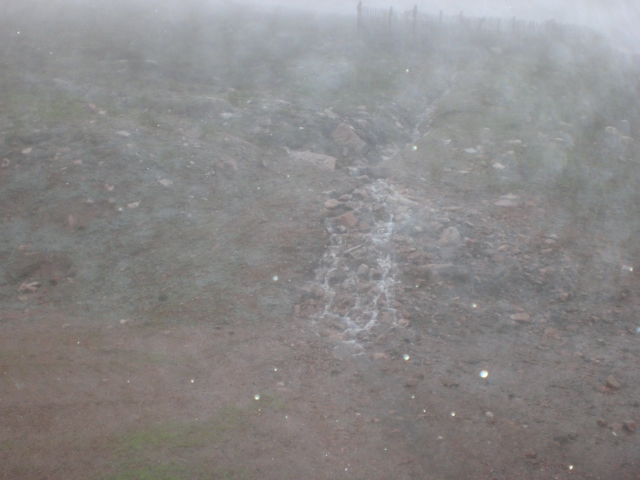
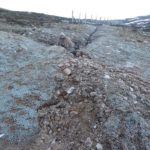 Water overflowing the drain created above the bulldozed slope and running down beside the Cas Gantry. You can see why the green fertiliser pellets have been washed away. The erosion has got worse since photo (left) previously featured in Parkswatch. Highlands and Island Enterprise and Natural Retreats have clearly done nothing to address the problem.
Water overflowing the drain created above the bulldozed slope and running down beside the Cas Gantry. You can see why the green fertiliser pellets have been washed away. The erosion has got worse since photo (left) previously featured in Parkswatch. Highlands and Island Enterprise and Natural Retreats have clearly done nothing to address the problem.
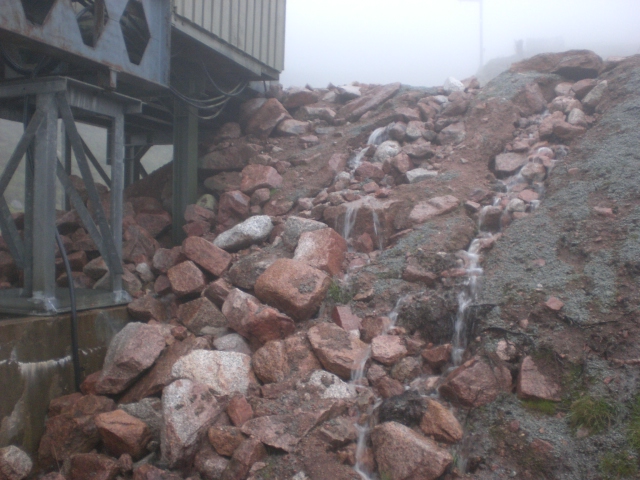 The erosion is even worse directly adjacent to the Cas Gantry, where water has removed all the top soil (the hare found strangled last week was under the girders to left of photo). Before Natural Retreats was allowed to undertake any work here, full planning permission should have been required, including hydrological surveys.
The erosion is even worse directly adjacent to the Cas Gantry, where water has removed all the top soil (the hare found strangled last week was under the girders to left of photo). Before Natural Retreats was allowed to undertake any work here, full planning permission should have been required, including hydrological surveys.
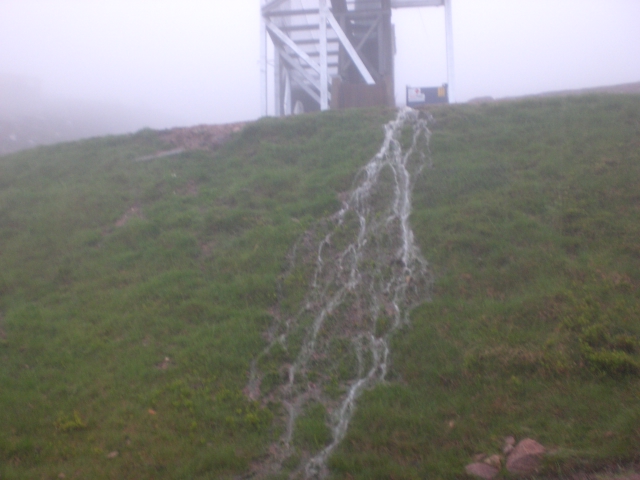
Below the gantry, the water runs down the bank which was re-seeded at an earlier date. This has helped limit the damage but for how long? No slope as steep as this will be able to withstand this amount of water for long. The problem is the works at Cairngorm have altered the pattern of water flows at Cairngorm, channelling water onto new ground which will not be able to withstand its erosive force.
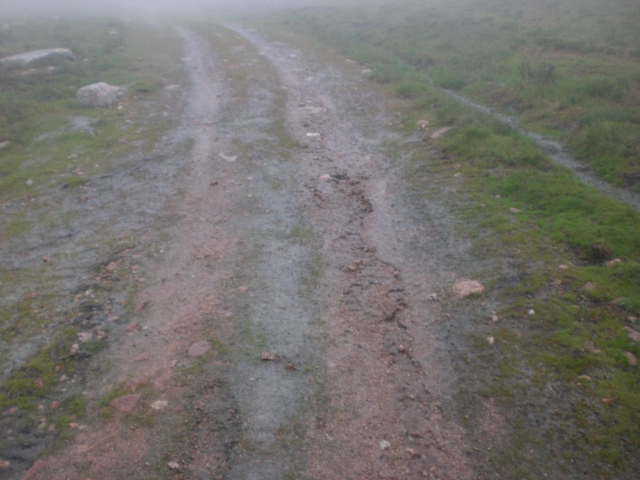 The unlawfully created Shieling hill track is on the slope below the bank. As predicted water is running straight down it and, after the dry spring and winter, one downpour has been sufficient to erode the track. The CNPA was warned that a track here was not only too steep, contravening SNH’s good practice guidance on hill tracks, but would serve to channel water more quickly off the hill, advice which it ignored. The suggestion from the North East Mountain Trust that the track be fully revegetated and that occasional use of vehicles over heather would do far less damage has so far been ignored.
The unlawfully created Shieling hill track is on the slope below the bank. As predicted water is running straight down it and, after the dry spring and winter, one downpour has been sufficient to erode the track. The CNPA was warned that a track here was not only too steep, contravening SNH’s good practice guidance on hill tracks, but would serve to channel water more quickly off the hill, advice which it ignored. The suggestion from the North East Mountain Trust that the track be fully revegetated and that occasional use of vehicles over heather would do far less damage has so far been ignored.
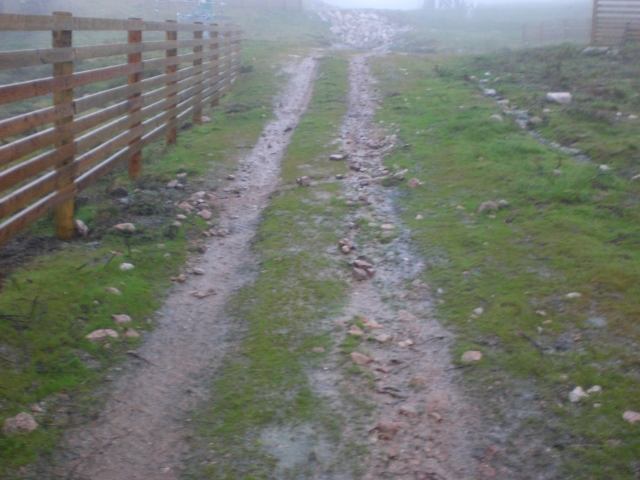
Washed out stones now litter the Shieling Hill Track.
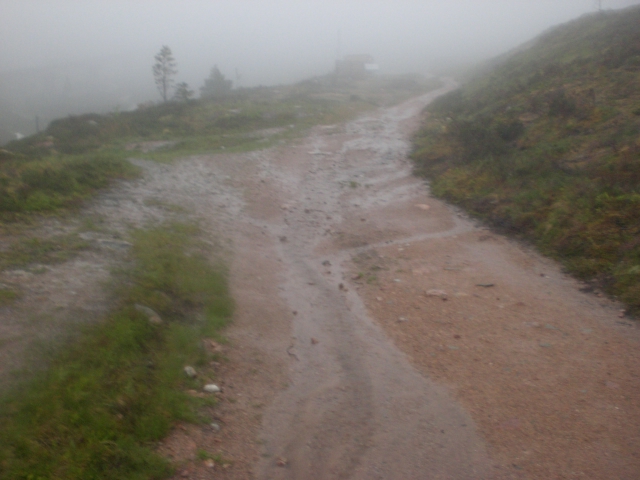 Below the bottom of the Shieling rope tow (far distance) and by the unlawfully re-graded bank, the track has become a burn. You can see how water from the bank which Natural Retreats claimed they had “improved”is flowing onto the track. There is no way of measuring how this compares to what happened before, but the destruction of vegetation on the bank is likely to have increased the rate of water run-off.
Below the bottom of the Shieling rope tow (far distance) and by the unlawfully re-graded bank, the track has become a burn. You can see how water from the bank which Natural Retreats claimed they had “improved”is flowing onto the track. There is no way of measuring how this compares to what happened before, but the destruction of vegetation on the bank is likely to have increased the rate of water run-off.

All this increased water run off is not only increasing erosion of the natural environment, its impacting on humans. The bottom of the Cas carpark was a raging torrent and is.being washed away and down into the lower Cas carpark. Below that of course is the Allt Coire Cas and the people of Aviemore.
What needs to happen
The only good thing about planning disaster at Cairngorm is that, unlike in the case of most hill tracks and other developments high up in the hills, what has happened is being closely monitored and well documented by activists. It should become a text book case of what not to do for every countryside planner in Scotland. It also provides all the evidence the Scottish Government should ever need about why ALL hill tracks should require full planning consent. What the hill track at Cairngorm shows is that as part of formal planning permission, all such tracks should require a detailed assessment of how they increase water run-off from the hill and what mitigatory measures, if any, could cancel this out. In my view where the impact cannot be 100% mitigated, the development should be refused – full stop! – as should have happened at Cairngorm.
I would never expect Natural Retreats to care about what has happened but the CNPA has repeatedly claimed that its concerned about flood prevention and limitation. So, when is it going to admit it has made a disastrous mistake at Cairngorm, start holding HIE and Natural Retreats to account and insist that they pay for a full hydrological survey which identifies options for addressing the problems highlighted here? As a first step, why not try North East Mountain Trust’s advice and re-vegetate the Shieling Hill track? As a second step, the CNPA could develop planning advice on hill tracks along with conservation organisations, re-inforcing the SNH guidance and supplementing this with information on flood prevention.
This is just dire. Back in 1982 the Lurcher’s Gully Public Inquiry showed clearly that the then Cairngorm Chairlift Company had only a very incomplete understanding of the difficult environmental problems it faced in managing the mountain. To be fair, hardly anybody else had much better understanding at that time. That’s no longer true, and it’s utterly dismaying to see that 35 years on Natural Retreats are betraying exactly the same failure of understanding, but apparently compounded by ignorance of, or contempt for, the good published advice that is now available. CNPA as planning authority must get a grip of this situation.
Shocking is a feeble word for this shameful disrespect for nature and total disregard for corporate responsibility. Cairngorm is not a builder’s yard. It is not a landfill site. It is not a disused quarry. Yet, from these pictures, it could be any one of these or all of them at the same time. I agree that CNPA must get its teeth into this. I hope it does have real teeth, not wallies.
This environmental disaster is taking place on publicly owned land. The Cabinet Secretary responsible is Fergus Ewing MSP. His responsibilities include oversight of Highlands and Islands Enterprise, the owners of the upper slopes of Cairn Gorm. He is also the local MSP with, in theory, detailed knowledge of what is happening today in the northern Cairngorms. We are seeing a repeat of all the mistakes make in the 1960s and 70s when large areas of fragile vegetation and soils were scraped off the upper slopes in order to make ski runs, roads and associated infrastructure. The developers were repeatedly warned of the consequences, especially in an area like the Cairngorms with its granitic rocks and loose mobile soils along with a reputation for intense, destructive rain storms. Too little was done too late in response to these warnings. The result was massive damage to the river system below Cairn Gorm in 1981 during one particularly intense storm. The public road was completely washed away close to where it crosses the river above Glenmore. It was fortunate that there was no loss of life, especially in the nearby Glenmore camp site which is seriously exposed to storm events on the hill above. We may not be so lucky next time. All these issues were explored in depth during the Lurchers Gully Public Inquiry and a related House of Commons Scottish Affairs Select Committee investigation. Fergus Ewing needs to be brought before a Scottish Parliament Committee to explain why he continues to support the utter incompetence of HIE in its management of the upper slopes of this mountain, why he and other SNP Ministers have failed to transfer ownership of all of the HIE land back to the Forestry Commission, as had previously been agreed, and whether the Glenmore Camp Site should be closed until the SNP Government demonstrates that it is capable of safeguarding these mountains and the people who live and stay on their lower flanks.